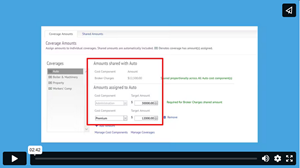News
The Challenges of Cost Allocation for Self-Insured Companies
August 9, 2023 Media, PA
Tech Insight

Self-insured companies must implement a cost allocation process to effectively distribute the premium charges across the divisions, cost centers, or accounts within the company. In an exposure-based allocation, premium charges are allocated according to the level of risk exposure for each account. The exposure level can be measured in terms of asset types, values, and quantities, or other factors that impact risk.
Whatever method is used, it must align with the organization’s risk profile, be both transparent and effective, and support overall risk management objectives. There are several key steps to developing a fair allocation process: identifying cost drivers, compiling accurate and consistent data, reviewing results, and adjusting the process as exposures change.
Quadra® readily supports the exposure-based allocation process by incorporating these steps directly into its Allocations module. Utilizing asset data, cost components, rate and coverage information, and a method for addressing ongoing asset changes, Quadra creates and distributes invoices efficiently to the client’s accounts.
Key features allowing for an effective allocation process include:
Consolidated exposure asset information – Quadra keeps all assets in one place, eliminating redundancies and ensuring all facets impacting premium charges are accounted for. All types of exposures can be accommodated and Quadra currently includes over 130 categories including vehicles, real estate, structures, and payroll.
Integration with accounts receivable – The module integrates with the Accounts Receivable module to facilitate a smooth collections process on behalf of the client. Quadra's Payment Processor will map coverages to funds and apply incoming payments to invoices. Clients can incorporate a lockbox or ACH for convenience. This capability also benefits clients that do not use Quadra’s A/R module but still rely on the allocation process to ensure that all asset changes are recorded and that premium charges are accurate. Invoices can be created as ‘reporting invoices’ which can be exported and integrated into an outside A/R system.
Automated invoice distribution -- One of Quadra’s supporting features for the Allocations module is Email Builder, which allows users to create invoices that can be automatically generated and sent to accounts. Email Builder will pull all send dates directly from the schedule and include recipient lists. This is a convenient method for preparing all emails in advance and ensuring they are delivered to the right contacts. Emails can be scheduled from within the Allocations module and can be paused and resumed as needed.
Schedule management for invoices and asset changes – While setting up a new allocation, users can specify dates for running an allocation, creating invoices, and making asset changes. The Allocation Schedule presents dates, amounts, and details, and features editing options for invoices or journal entries. For clients that need to prepare invoices and reports in advance of the scheduled date, users can force a future date on the schedule.
Monitor results -- A preview feature shows all assets and charges before the reports and invoices are run. At this step, users can perform searches to find details on specific charges. Additionally, an Allocation Charges report is available listing all asset changes and invoices for an allocation. This benefits users that need to export the data for analysis or for sharing with team members.
Simplified renewal process -- Users can renew an allocation by copying the previous year’s data, which saves time during preparations for a new fiscal year. Plus, options are available to keep the previous year’s existing overrides, increase all dates by one year, and copy as a renewal or not.
Many of our customers came to AETI in search of a more streamlined method for allocating charges. After negotiating a challenging environment involving spreadsheets, siloed data, and guesswork, Quadra has proved to be a game changer in terms of its ability to support the allocation process from start to finish. As a result, finance professionals have confidence that the charges generated will be accurate and reflective of each account’s risk profile.
An overview of the Allocations module is available:
At AETI®, we are committed to helping our clients protect their assets and ensure their viability for the future through effective insurance program management. Our product Quadra manages over $40.1B in exposures across 11,700+ accounts. It is a valuable tool for commercial property and casualty insurance brokers, nonprofits, risk retention groups, insurance pools, captive insurers, trusts, and REITs. If you are interested in learning more about how Quadra can support your program, please contact us!
Subscribe to our newsletter
Tags
Conferences (26)Holiday Card (12)
NetInfoNow (1)
New Features (37)
Quadra (100)
Software Releases (75)
Tech Insight (14)
Tutorials (15)
